
ROCSYS founder Crijn Bouman is no stranger to innovation. A self-described “entrepreneur at heart,” Bouman has led two Netherlands-based startups in cleantech, software, and electronics. When his first EV fast charging equipment company Epyon was acquired by ABB almost a decade ago, he stayed on as Head of Product Management for its charging portfolio for about six years. Eventually, the siren song of a new startup caught up to him, and he left ABB to steer back onto an entrepreneurial course.
Bouman began collaborating with co-founders Joost van der Weijde and Kanter Van Deurzen in 2019, and the foundations for ROCSYS were quickly laid. The startup recognized that the next generation of EVs would need fully automated charging stations, and set to work developing what he refers to as the “2.0 version” of charging infrastructure—a robotic arm guided by computer vision that can work with any charging station. “It doesn’t make sense to have to manually plug it in while the vehicle can just park itself,” Bouman told Charged. However, he admits that automated charging stations for self-driving consumer EVs are still a little further out on the horizon for ROCSYS. “At the moment, there is already a significant need for automated charging in professional fleets, where there is a reason for automation. So you can think of harbors, logistic fleets, industrial fleets…where plugging in by the driver is impossible, inefficient or impractical.”
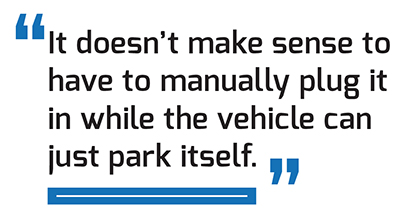
Safe harbors
The Dutch have a long history of improving the efficiency of ports and logistics centers, and ROCSYS plans on continuing that tradition with its automated charging technologies. Many ports, industrial areas and logistics operations already use automated guided vehicles. Container carriers, cargo trucks, shuttles and various types of logistics vehicles can now zip around facilities with minimal human interference. Some of these vehicles, however, rely on sources such as pantographs to deliver power. “With the current industry standard CCS connector, we can deliver up to 400 kW of charging power with a robot, which is a one-on-one equivalent to the pantograph charging system, and we will exceed 1 MW soon with new plug standards coming to market,” says Bouman. In an environment rife with moving parts, many of which weigh several tons, dispensing with extraneous wires and rails could improve safety.
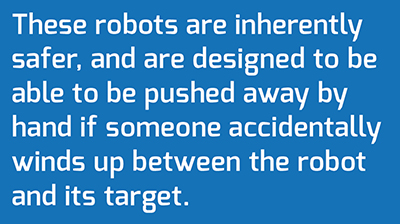
Automated charging tech can help streamline an overall logistics workflow and reduce human error, but ROCSYS robots take safety even further. “Another aspect which is quite important is that if you have a robot within a public area, it needs to be intrinsically safe,” says Bouman. “If there is a person stepping in between the robot and the vehicle, you must be sure that [it] cannot harm the person.” According to Bouman, traditional robots are very unsafe due to their strength, and the fact that they are position-controlled. ROCSYS chargers implement soft robotics technologies. These robots are inherently safer, and are designed to be able to be pushed away by hand if someone accidentally winds up between the robot and its target.
Benefits of AI
Soft robots are flexible and adaptable, their design is based more on living organisms than a traditional robot. Bouman and his team of engineers have combined these traits with sensor tech to achieve a safer system that can also account for human error. For instance, if a human places her hand between the robotic charging arm and the port, the robot will make contact but is physically unable to hurt the human. Bouman likens it to an elastic system: “You can just push it back, and that’s actually the core of the technology. It has a lot of benefits, being low-cost and safe, and it also has the possibility to deal with unexpected situations.”
The robotic charging arms combine AI software with computer vision, in which the robot draws information from a camera in order to home in on the precise location of the vehicle. From these relative coordinates, it can determine where to place the plug—a slightly slower version of how our brain processes the images it receives from our eyes. “It’s very much like a human would insert the plug,” says Bouman. “It just looks where you have to go, then moves closer to the area where it needs to be by recurring observation and adjustment.”
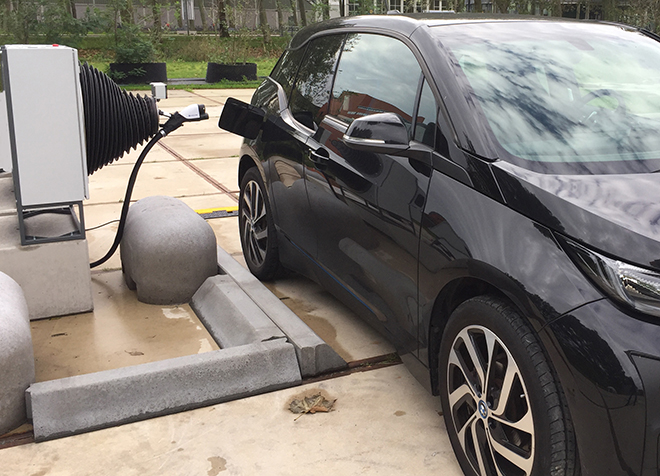
Compatibility and communication
One of the primary design principles driving the team is universal compatibility. “We are aiming to make it compatible with any charger on the market. So basically, the only integration you need to do is mount the plug to the robot, and the robots can deal with the rest.” Bouman seeks to make a product that is both retrofittable to existing charging sites and usable with any new greenfield project. “Maybe at some point we would develop a special integration with a charger supplier or so. But at the moment we’d like to be charger-supplier-agnostic, so it should work with any charger.”
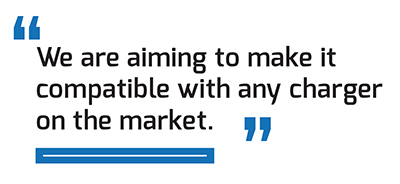
As it stands, the system does not require advanced communication with the vehicle. The robot can determine where to go and effectively connect the plug without a direct exchange with the car. However, a communication protocol is already in the pipeline. This would enable the vehicle to park in a given location and automatically open the cover to its charge port, further streamlining the charging experience. The Tesla Model 3 already uses radio frequency communication to talk to the charging arm, and other manufacturers are starting to do the same. Tesla did, in fact, release a video way back in 2015 of its own automated EV charging device, but has yet to release any further updates or information on that project.
A turnkey solution
ROCSYS isn’t limiting its reach to the charging arm. In the future, professional fleets and public charging operators will both be looking for a combination of robots, infrastructure and services to set up an efficient charging system. While the company is focused primarily on getting the robot market-ready, its ultimate goal is to deliver a completely automated charging experience. “A conceptual analogy would be a car wash-like scenario where you have an input, where you drop off the vehicles, and the output, where the charged vehicles exit,” explains Bouman. He aims to achieve this through a fully automated charging site, blending charging stations with multiple robots in one location.
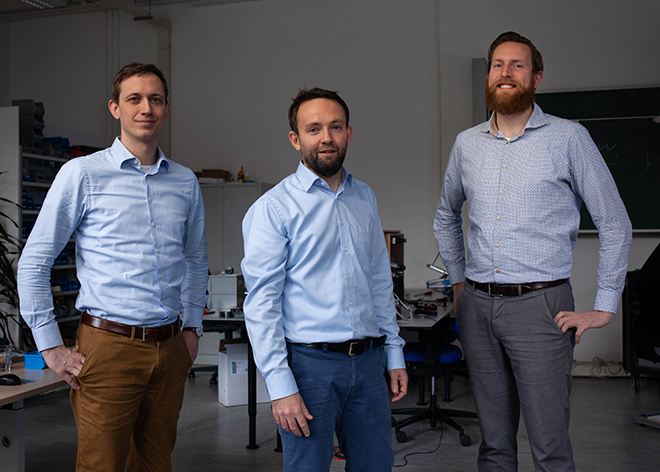
So how, exactly, does ROCSYS propose to serve multiple parked cars from one position? Bouman admits there are some logistical puzzles: “It’s not like an R2-D2 type of robot, which is driving [around] the parking garage. Basically, there’s a rail system in the ground where the robots can move along a row of vehicles.” This helps to optimize charging operators’ assets. “If they are installing a 350 kW charger, it’s a $100,000-plus investment per charger. So they want this equipment to be running all the time, every time.” By taking the driver—who is likely to occupy a charger for longer than necessary by catching up on emails or running an errand while his vehicle is still plugged in—out of the equation, ROCSYS can improve the charging station’s top line. Chargers hooked up to a central infrastructure can immediately unplug when the vehicle reaches a set limit, and move on to the next car.
Bouman hopes to offer a system in which each charger could consistently run at the highest possible rate, rather than wasting time while it waits for human intervention. Bouman’s philosophy? “To make sure that every asset is utilized to the max.” The way he sees it, from container carriers to carparks, a turnkey EV charging solution is just an automated arm’s length away.
This article appeared in Charged Issue 47 – January/February 2020 – Subscribe now.
source https://chargedevs.com/features/rocsys-automates-charging-stations-with-soft-robots/
No comments:
Post a Comment